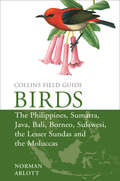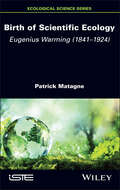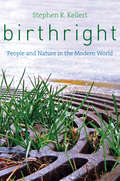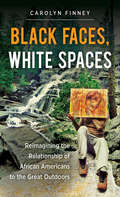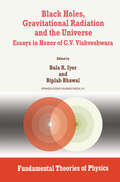- Table View
- List View
Birds of Prey and Wind Farms: Analysis of Problems and Possible Solutions
by Hermann Hötker Oliver Krone Georg NehlsThis book discusses the increase in number and capacity of wind farms in Germany and how this is affecting birds of prey. Several methods are used to study the behaviour of birds of prey in relation to wind farms, including telemetry data, field observations, and comparisons of turbine base areas. Special attention is given to the effects on different bird species and the impact wind farms may have on population growth and breeding success of birds of prey. Chapter 6 discusses the collision risks at wind turbines and provides an analysis of the fatalities. In the concluding chapter, ideas are put forward to help minimize conflicts, estimate risks, and offer practical recommendations for future research. This book will be of interest to wind farm developers, researchers, applied ecologists and landscape planners.
Birds of the Philippines: and Sumatra, Java, Bali, Borneo, Sulawesi, the Lesser Sundas and the Moluccas (Collins Field Guides)
by Norman ArlottThis comprehensive new field guide is an excellent addition to the world-renowned series – the ultimate reference book for travelling birdwatchers.
The Birds They Sang: Birds and People in Life and Art
by Stanisław ŁubieńskiBirds have inspired people since the dawn of time. They are the notes behind Mozart’s genius, the colours behind Audubon’s art and ballet’s swansong.In The Birds They Sang, Stanisław Łubienski sheds light on some of history’s most meaningful bird and human interactions, from historical bird watchers in a German POW camp, to Billy and Kes in A Kestrel for a Knave. He muses on what exactly Hitchcock’s birds had in mind and reveals the true story behind the real James Bond. Undiscouraged by damp, discomfort and a reed bunting’s curse, Łubienski bears witness to the difficulties birds face today, as people fail to accommodate them in rapidly changing times.A soaring exploration of our fascination with birds, The Birds They Sang opens a vast realm of astonishing sounds, colours and meanings – a complete world in which we humans are never alone.
A Birman-Schwinger Principle in Galactic Dynamics (Progress in Mathematical Physics #77)
by Markus KunzeThis monograph develops an innovative approach that utilizes the Birman-Schwinger principle from quantum mechanics to investigate stability properties of steady state solutions in galactic dynamics. The opening chapters lay the framework for the main result through detailed treatments of nonrelativistic galactic dynamics and the Vlasov-Poisson system, the Antonov stability estimate, and the period function $T_1$. Then, as the main application, the Birman-Schwinger type principle is used to characterize in which cases the “best constant” in the Antonov stability estimate is attained. The final two chapters consider the relation to the Guo-Lin operator and invariance properties for the Vlasov-Poisson system, respectively. Several appendices are also included that cover necessary background material, such as spherically symmetric models, action-angle variables, relevant function spaces and operators, and some aspects of Kato-Rellich perturbation theory. A Birman-Schwinger Principle in Galactic Dynamics will be of interest to researchers in galactic dynamics, kinetic theory, and various aspects of quantum mechanics, as well as those in related areas of mathematical physics and applied mathematics.
Birth of Scientific Ecology: Eugenius Warming (1841 - 1924)
by Patrick MatagneThis book presents a biography of the Danish botanist Eugen Warming. As the author of a treatise on ecology that brought him international recognition, he was able to inspire the first generation of 20th-century European and American ecologists. His innovative approach to nature and his Arctic and tropical missions heralded the birth of a new science and an ecological awareness. As a professor at several Scandinavian universities during a period of intense debate and controversy over evolutionary theories, Eugen Warming vigorously asserted his convictions. Birth of Scientific Ecology presents the image of a man of knowledge and power, recognized by his contemporaries as a founder of ecology and a player in the ecological project of the Kingdom of Denmark at a time when the empires were clashing.
Birth of Scientific Ecology: Eugenius Warming (1841 - 1924)
by Patrick MatagneThis book presents a biography of the Danish botanist Eugen Warming. As the author of a treatise on ecology that brought him international recognition, he was able to inspire the first generation of 20th-century European and American ecologists. His innovative approach to nature and his Arctic and tropical missions heralded the birth of a new science and an ecological awareness. As a professor at several Scandinavian universities during a period of intense debate and controversy over evolutionary theories, Eugen Warming vigorously asserted his convictions. Birth of Scientific Ecology presents the image of a man of knowledge and power, recognized by his contemporaries as a founder of ecology and a player in the ecological project of the Kingdom of Denmark at a time when the empires were clashing.
The Birth of Territory
by Stuart EldenTerritory is one of the central political concepts of the modern world and, indeed, functions as the primary way the world is divided and controlled politically. Yet territory has not received the critical attention afforded to other crucial concepts such as sovereignty, rights, and justice. While territory continues to matter politically, and territorial disputes and arrangements are studied in detail, the concept of territory itself is often neglected today. Where did the idea of exclusive ownership of a portion of the earth’s surface come from, and what kinds of complexities are hidden behind that seemingly straightforward definition? The Birth of Territory provides a detailed account of the emergence of territory within Western political thought. Looking at ancient, medieval, Renaissance, and early modern thought, Stuart Elden examines the evolution of the concept of territory from ancient Greece to the seventeenth century to determine how we arrived at our contemporary understanding. Elden addresses a range of historical, political, and literary texts and practices, as well as a number of key players—historians, poets, philosophers, theologians, and secular political theorists—and in doing so sheds new light on the way the world came to be ordered and how the earth’s surface is divided, controlled, and administered.
The Birth of Territory
by Stuart EldenTerritory is one of the central political concepts of the modern world and, indeed, functions as the primary way the world is divided and controlled politically. Yet territory has not received the critical attention afforded to other crucial concepts such as sovereignty, rights, and justice. While territory continues to matter politically, and territorial disputes and arrangements are studied in detail, the concept of territory itself is often neglected today. Where did the idea of exclusive ownership of a portion of the earth’s surface come from, and what kinds of complexities are hidden behind that seemingly straightforward definition? The Birth of Territory provides a detailed account of the emergence of territory within Western political thought. Looking at ancient, medieval, Renaissance, and early modern thought, Stuart Elden examines the evolution of the concept of territory from ancient Greece to the seventeenth century to determine how we arrived at our contemporary understanding. Elden addresses a range of historical, political, and literary texts and practices, as well as a number of key players—historians, poets, philosophers, theologians, and secular political theorists—and in doing so sheds new light on the way the world came to be ordered and how the earth’s surface is divided, controlled, and administered.
The Birth of Territory
by Stuart EldenTerritory is one of the central political concepts of the modern world and, indeed, functions as the primary way the world is divided and controlled politically. Yet territory has not received the critical attention afforded to other crucial concepts such as sovereignty, rights, and justice. While territory continues to matter politically, and territorial disputes and arrangements are studied in detail, the concept of territory itself is often neglected today. Where did the idea of exclusive ownership of a portion of the earth’s surface come from, and what kinds of complexities are hidden behind that seemingly straightforward definition? The Birth of Territory provides a detailed account of the emergence of territory within Western political thought. Looking at ancient, medieval, Renaissance, and early modern thought, Stuart Elden examines the evolution of the concept of territory from ancient Greece to the seventeenth century to determine how we arrived at our contemporary understanding. Elden addresses a range of historical, political, and literary texts and practices, as well as a number of key players—historians, poets, philosophers, theologians, and secular political theorists—and in doing so sheds new light on the way the world came to be ordered and how the earth’s surface is divided, controlled, and administered.
The Birth of Territory
by Stuart EldenTerritory is one of the central political concepts of the modern world and, indeed, functions as the primary way the world is divided and controlled politically. Yet territory has not received the critical attention afforded to other crucial concepts such as sovereignty, rights, and justice. While territory continues to matter politically, and territorial disputes and arrangements are studied in detail, the concept of territory itself is often neglected today. Where did the idea of exclusive ownership of a portion of the earth’s surface come from, and what kinds of complexities are hidden behind that seemingly straightforward definition? The Birth of Territory provides a detailed account of the emergence of territory within Western political thought. Looking at ancient, medieval, Renaissance, and early modern thought, Stuart Elden examines the evolution of the concept of territory from ancient Greece to the seventeenth century to determine how we arrived at our contemporary understanding. Elden addresses a range of historical, political, and literary texts and practices, as well as a number of key players—historians, poets, philosophers, theologians, and secular political theorists—and in doing so sheds new light on the way the world came to be ordered and how the earth’s surface is divided, controlled, and administered.
The Birth of Territory
by Stuart EldenTerritory is one of the central political concepts of the modern world and, indeed, functions as the primary way the world is divided and controlled politically. Yet territory has not received the critical attention afforded to other crucial concepts such as sovereignty, rights, and justice. While territory continues to matter politically, and territorial disputes and arrangements are studied in detail, the concept of territory itself is often neglected today. Where did the idea of exclusive ownership of a portion of the earth’s surface come from, and what kinds of complexities are hidden behind that seemingly straightforward definition? The Birth of Territory provides a detailed account of the emergence of territory within Western political thought. Looking at ancient, medieval, Renaissance, and early modern thought, Stuart Elden examines the evolution of the concept of territory from ancient Greece to the seventeenth century to determine how we arrived at our contemporary understanding. Elden addresses a range of historical, political, and literary texts and practices, as well as a number of key players—historians, poets, philosophers, theologians, and secular political theorists—and in doing so sheds new light on the way the world came to be ordered and how the earth’s surface is divided, controlled, and administered.
The Birth of Territory
by Stuart EldenTerritory is one of the central political concepts of the modern world and, indeed, functions as the primary way the world is divided and controlled politically. Yet territory has not received the critical attention afforded to other crucial concepts such as sovereignty, rights, and justice. While territory continues to matter politically, and territorial disputes and arrangements are studied in detail, the concept of territory itself is often neglected today. Where did the idea of exclusive ownership of a portion of the earth’s surface come from, and what kinds of complexities are hidden behind that seemingly straightforward definition? The Birth of Territory provides a detailed account of the emergence of territory within Western political thought. Looking at ancient, medieval, Renaissance, and early modern thought, Stuart Elden examines the evolution of the concept of territory from ancient Greece to the seventeenth century to determine how we arrived at our contemporary understanding. Elden addresses a range of historical, political, and literary texts and practices, as well as a number of key players—historians, poets, philosophers, theologians, and secular political theorists—and in doing so sheds new light on the way the world came to be ordered and how the earth’s surface is divided, controlled, and administered.
Birth of the Shinkansen: The Origin Story of the World-First Bullet Train
by Tetsuo ShimomaeThis book discusses the Shinkansen, the world's first high-speed railway, which was born in Japan in 1964 and how it has developed up to the present day. In the 1950s, some European railways were trying to increase the commercial operating speed up to 160 km/h, and it was considered difficult to raise it to 200 km/h. Japanese engineers with excellent engineering ability post World War ll moved from the military to the railways to overcome the technological challenges realizing the high-speed railways using new approaches. The book discusses the technological barriers in speeding up the railway at that time and how these engineers overcame them in non-computer days. In the five decades since the Shinkansen began operating, there have been significant developments enabling high-speed, safe, and frequent train operation with high punctuality while conserving the environment. The book also describes today’s highly evolved Shinkansen. The Shinkansen, which runs 440,000 km a day, has carried 13.3 billion people without a single fatality in 56 years. The book overviews factors that contributed to the Shinkansen’s high safety record. This book is an excellent guide for those interested in the history of the world’s first high-speed railway.
Birthright: People and Nature in the Modern World
by Stephen R. KellertHuman health and well-being are inextricably linked to nature; our connection to the natural world is part of our biological inheritance. In this engaging book, a pioneer in the field of biophilia—the study of human beings' inherent affinity for nature—sets forth the first full account of nature's powerful influence on the quality of our lives. Stephen Kellert asserts that our capacities to think, feel, communicate, create, and find meaning in life all depend upon our relationship to nature. And yet our increasing disconnection and alienation from the natural world reflect how seriously we have undervalued its important role in our lives.Weaving scientific findings together with personal experiences and perspectives, Kellert explores specific human tendencies—including affection, aversion, intellect, control, aesthetics, exploitation, spirituality, and communication—to discover how they are influenced by our relationship with nature. He observes that a beneficial relationship with the natural world is an instinctual inclination, but must be earned. He discusses how we can restore the balance in our relationship by means of changes in childhood development, education, conservation, building design, ethics, and everyday life. Kellert's moving book provides exactly what is needed now: a fresh understanding of how much our essential humanity relies on being a part of the natural world.
Bitch: A Revolutionary Guide to Sex, Evolution and the Female Animal
by Lucy Cooke'A book that is tearing down the stereotypes and the biases. Absolutely fascinating.' BBC R4 Woman's Hour'From the heir to Attenborough. 5*' - Telegraph'Colourful, committed and deeply informed.' Sunday Times'Beautifully written, very funny and deeply important - Lucy Cooke blows two centuries of sexist myths right out of biology.' PROFESSOR ALICE ROBERTS 'Mr Darwin, your time is up...This is the evolutionary reboot us bitches have been waiting for.' SUE PERKINS_______________________________________________________________What does it mean to be female? Mother, carer, the weaker sex? Think again.In the last few decades a revolution has been brewing in zoology and evolutionary biology. Lucy Cooke introduces us to a riotous cast of animals, and the scientists studying them, that are redefining the female of the species.Meet the female lemurs of Madagascar, our ancient primate cousins that dominate the males of their species physically and politically.Or female albatross couples, hooking up together to raise their chicks in Hawaii.Or the meerkat mothers of the Kalahari Desert - the most murderous mammals on the planet.The bitches in BITCH overturn outdated binary expectations of bodies, brains, biology and behaviour. Lucy Cooke's brilliant new book will change how you think - about sex, sexual identity and sexuality in animals and also the very forces that shape evolution.__________Praise for Lucy's previous book THE UNEXPECTED TRUTH ABOUT ANIMALS'Endlessly fascinating' - Bill Bryson'I cannot remember when I enjoyed a non-fiction book so much' - Daily Express'A joy from beginning to end' - Guardian'Best science pick: deeply researched, sassily written' - Nature
The Bitcoin Dilemma: Weighing the Economic and Environmental Costs and Benefits
by Colin L. ReadThere are few innovations that have the potential to revolutionize commerce and have evolved so quickly that there remain significant misunderstandings about their operation, opportunity, and challenges as has Bitcoin in the dozen years since its invention. The potential for banking, transacting, and public recording of important records is profound, but can be displacing if not done with appropriate care, and is downright dangerous if certain pitfalls are not noted and avoided. Among other things, this book proves the existence of a Bitcoin dilemma that challenges the conventional wisdom which mistakenly asserts the incredibly intensive energy consumption in Proof-of-Work cryptocurrency mining will be remedied by more efficient mining machines or sustainable power sources. It shows for the first time within a well-specified economic model of Bitcoin mining that the recent runup in electricity consumption has a simple and inevitable explanation. For a coin with almost completely inelastic supply and steadily increasing demand, the conditions for accelerating electricity demand is consistent with economic theory and may well characterize the future of Bitcoin. The book also demonstrates the counterintuitive result that improvements in mining efficiency, in terms of electricity consumption per terahash of processing power, or decreases in electricity costs as cheaper sustainable energy is diverted to this industry, merely exacerbates the acceleration of energy consumption because of a prisoner’s dilemma arms-race-to-the-bottom. The book proposes policy solutions to mitigate this Bitcoin dilemma but note that the mobility of industry capacity which needs but a ready supply of electricity and an Internet connection frustrates local regulation and warrants global solutions. The incredible opportunities of this industry will only be realized if our regulators, legislators, entrepreneurs, and general public garner a more complete and objective understanding of this and other Proof-of-Work mining techniques. The book provides this broader perspective based on the author’s research as an economist, his position as a director of a large regional bank, his understanding as a technologist and as an environmental and sustainability researcher, and his public policy experience as a mayor who has also written books and articles about public policy and public finance.
Bitumens in Ore Deposits (Special Publication of the Society for Geology Applied to Mineral Deposits #9)
by P. Landais HenrykKucha JohnParnellThe Black Earth: Ecological Principles for Sustainable Agriculture on Chernozem Soils (International Year of Planet Earth)
by Igori Arcadie Krupenikov Boris P Boincean David DentSoil is the Earth’s living skin. It provides anchorage for roots, holds water long enough for plants to make use of it and the nutrients that sustain life – otherwise the Earth would be as barren as Mars. It is home to myriad micro-organisms and armies of microscopic animals as well as the familiar earthworm that accomplish biochemical transformations from fixing atmospheric nitrogen to recycling wastes; it receives and process all fresh water, provides the foundations for our built environment; and comprises the biggest global carbon store that we know how to manage. This book is about the best soil in the world - the black earth or chernozem: how it is being degraded by farming and how it may be farmed sustainably. Industrialisation of farming has laid bare contradictions between the unforgiving laws of ecology and economics. Soil organic matter is the fuel that powers soil systems and the cement that holds the soil together – and in place – but agriculture is burning it up faster than it is being formed: even the chernozem cannot long survive this treatment. Here is the evidence for this trend and, based on long-term field experiments, ecological principles for sustainable agriculture that can reverse the trend and, at the same time, feed the world. Unlike other volumes in the series, this is not an edited collection of scientific papers. The authors have chosen the classical monograph to be near to the reader from beginning to end - to convey their anxiety about the state of the land and their optimism about the possibility of retrieving the situation by changing the social and political approach to the land so as to provide the necessary incentives for sustainable land use and management.
Black Faces, White Spaces: Reimagining the Relationship of African Americans to the Great Outdoors
by Carolyn FinneyWhy are African Americans so underrepresented when it comes to interest in nature, outdoor recreation, and environmentalism? In this thought-provoking study, Carolyn Finney looks beyond the discourse of the environmental justice movement to examine how the natural environment has been understood, commodified, and represented by both white and black Americans. Bridging the fields of environmental history, cultural studies, critical race studies, and geography, Finney argues that the legacies of slavery, Jim Crow, and racial violence have shaped cultural understandings of the "great outdoors" and determined who should and can have access to natural spaces. Drawing on a variety of sources from film, literature, and popular culture, and analyzing different historical moments, including the establishment of the Wilderness Act in 1964 and the aftermath of Hurricane Katrina, Finney reveals the perceived and real ways in which nature and the environment are racialized in America. Looking toward the future, she also highlights the work of African Americans who are opening doors to greater participation in environmental and conservation concerns.
Black Hole Gravitohydromagnetics (Astrophysics and Space Science Library #355)
by Brian PunslyBlack hole gravitohydromagnetics (GHM) is developed from the rudiments to the frontiers of research in this book. GHM describes plasma interactions that combine the effects of gravity and a strong magnetic field, in the vicinity (ergosphere) of a rapidly rotating black hole. This topic was created in response to the astrophysical quest to understand the central engines of radio loud extragalactic radio sources. The theory describes a "torsional tug of war" between rotating ergospheric plasma and the distant asymptotic plasma that extracts the rotational inertia of the black hole. The recoil from the struggle between electromagnetic and gravitational forces near the event horizon is manifested as a powerful pair of magnetized particle beams (jets) that are ejected at nearly the speed of light. This second edition of the book is updated throughout and contains a completely new chapter discussing state of the art and results of numerical simulations of ergospheric disk jets occurring in magnetohydrodynamic accretion flows.
The Black Hole-Neutron Star Binary Merger in Full General Relativity: Dependence on Neutron Star Equations of State (Springer Theses)
by Koutarou KyutokuThis thesis presents a systematic study of the orbital evolution, gravitational wave radiation, and merger remnant of the black hole–neutron star binary merger in full general relativity for the first time. Numerical-relativity simulations are performed using an adaptive mesh refinement code, SimulAtor for Compact objects in Relativistic Astrophysics (SACRA), which adopts a wide variety of zero-temperature equations of state for the neutron star matter. Gravitational waves provide us with quantitative information on the neutron star compactness and equation of state via the cutoff frequency in the spectra, if tidal disruption of the neutron star occurs before the binary merges. The cutoff frequency will be observed by next-generation laser interferometric ground-based gravitational wave detectors, such as Advanced LIGO, Advanced VIRGO, and KAGRA. The author has also determined that the mass of remnant disks are sufficient for the remnant black hole accretion disk to become a progenitor of short-hard gamma ray bursts accompanied by tidal disruptions and suggests that overspinning black holes may not be formed after the merger of even an extremely spinning black hole and an irrotational neutron star.
Black Hole Physics: Basic Concepts and New Developments (Fundamental Theories of Physics #96)
by V. Frolov I. NovikovIt is not an exaggeration to say that one of the most exciting predictions of Einstein's theory of gravitation is that there may exist "black holes": putative objects whose gravitational fields are so strong that no physical bodies or signals can break free of their pull and escape. The proof that black holes do exist, and an analysis of their properties, would have a significance going far beyond astrophysics. Indeed, what is involved is not just the discovery of yet another even if extremely remarkable, astro physical object, but a test of the correctness of our understanding of the properties of space and time in extremely strong gravitational fields. Theoretical research into the properties of black holes, and into the possible corol laries of the hypothesis that they exist, has been carried out with special vigor since the beginning of the 1970's. In addition to those specific features of black holes that are important for the interpretation of their possible astrophysical manifestations, the theory has revealed a number of unexpected characteristics of physical interactions involving black holes. By the middle of the 1980's a fairly detailed understanding had been achieved of the properties of the black holes, their possible astrophysical manifestations, and the specifics of the various physical processes involved. Even though a completely reliable detection of a black hole had not yet been made at that time, several objects among those scrutinized by astrophysicists were considered as strong candidates to be confirmed as being black holes.
Black Hole Physics (Nato Science Series C: #364)
by V. De Sabbata Zhenjiu Zhenjiu ZhangIn these last years Black hole Physics has developed rapidly both from theoretical and observational aspects: especially as regards quantum aspects many things must be clarified as for instance the processes occuring near mini black holes with spontaneous creation of particles that eventually lead to the evaporation of black hole. In these last stages probably a connection with string theory will appears. This field of research was subject of the NATO Adavanced study Institute on "Black Hole Physics" which was held at the Ettore Majorana Center for Scientific Culture in Erice (Sicily, th Italy) from May 12th through May 22 , 1991. It was at the same time the 12th Course of the International School of Cosmology and Gravitation. During this 12th Course, after recalling the starting point that is the concept of black hole in Newton theory, the lectures are gone through classical, quantum, cosmological and astrophysical aspects. Of course in order to understand fully the behaviour of these objects one is faced with a large number of broad areas related to different branches of physics. In fact have been widely treated not only classical aspects, thermodynamics, entropy, internal dynamics, cosmology, inflation and astrophysics but quantum behaviour involving creation of particles, Hawking rad iation, until the modern theory of strings and superstrings that claims the unification of all interactions. So the physics involved and discussed in the various lectures goes from cosmology and very early universe to that of elementary particles including neutrino physics.
Black Holes: The Reith Lectures
by Stephen Hawking“It is said that fact is sometimes stranger than fiction, and nowhere is that more true than in the case of black holes. Black holes are stranger than anything dreamed up by science fiction writers.”In 2016 Professor Stephen Hawking delivered the BBC Reith Lectures on a subject that fascinated him for decades – black holes.In these flagship lectures the legendary physicist argued that if we could only understand black holes and how they challenge the very nature of space and time, we could unlock the secrets of the universe.
Black Holes, Gravitational Radiation and the Universe: Essays in Honor of C.V. Vishveshwara (Fundamental Theories of Physics #100)
by B. R. Iyer B. BhawalOur esteemed colleague C. V. Vishveshwara, popularly known as Vishu, turned sixty on 6th March 1998. His colleagues and well wishers felt that it would be appropriate to celebrate the occasion by bringing out a volume in his honour. Those of us who have had the good fortune to know Vishu, know that he is unique, in a class by himself. Having been given the privilege to be the volume's editors, we felt that we should attempt something different in this endeavour. Vishu is one of the well known relativists from India whose pioneer ing contributions to the studies of black holes is universally recognised. He was a student of Charles Misner. His Ph. D. thesis on the stability of the Schwarzschild black hole, coordinate invariant characterisation of the sta tionary limit and event horizon for Kerr black holes and subsequent seminal work on quasi-normal modes of black holes have passed on to become the starting points for detailed mathematical investigations on the nature of black holes. He later worked on other aspects related to black holes and compact objects. Many of these topics have matured over the last thirty years. New facets have also developed and become current areas of vigorous research interest. No longer are black holes, ultracompact objects or event horizons mere idealisations of mathematical physicists but concrete entities that astrophysicists detect, measure and look for. Astrophysical evidence is mounting up steadily for black holes.

